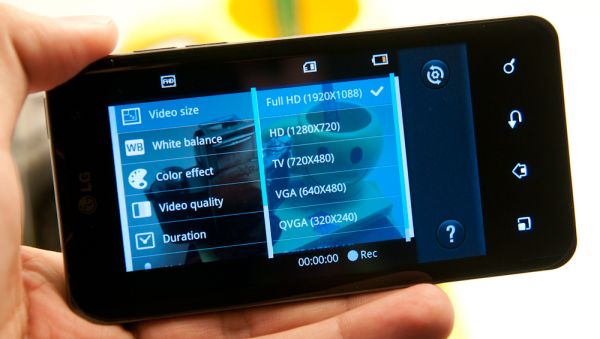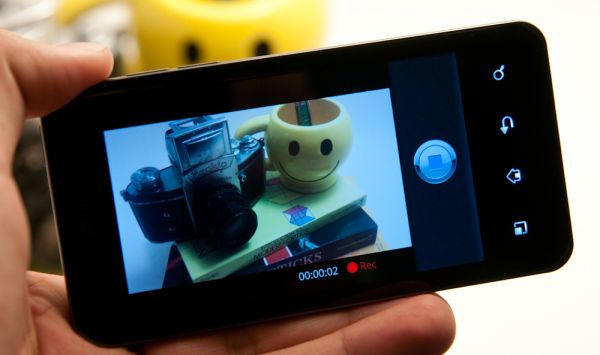LG Optimus 2X & NVIDIA Tegra 2 Review: The First Dual-Core Smartphone
by Brian Klug & Anand Lal Shimpi on February 7, 2011 3:53 AM EST- Posted in
- Smartphones
- Tegra 2
- LG
- Optimus 2X
- Mobile
- NVIDIA
Video Capture
The other big part of the 2X is that it’s the first smartphone to do H.264 1080P video capture. We took the 2X out to our usual test site and recorded video on the 2X at every quality setting at 1080p, and at maximum quality at 720P and VGA resolutions, and one final video with the front facing camera. I looked at the videos and then had Ganesh, our resident media center and video expert, as well as Anand take a look at the same original videos and compare to our other devices. It’s hard to argue that the iPhone 4 and Nokia N8 aren’t the devices to beat, both of them cranking out impressively sharp 720P video. We’ve done the usual thing and uploaded all the test videos to YouTube in addition to making a big zip for comparison in their original glory—links are in the table below.
Before we get to our comparison, a little background. First off, the 2X records 1920x1088 video in H.264 Baseline profile at an average of around 12 Mbps, audio is 1 channel AAC at 64 Kbps. The specifications for the 2x say 1080p24, in practice I’ve seen some framerate variability between 24 and 30 depending on lighting conditions. These videos are close to but not exactly 30 FPS, two videos I shot with the 2X at CES are clearly 24 FPS. Why the extra 8 pixels of vertical resolution, you might be wondering? The reason is simple—1088 is an even factor of 16, and macroblocks are 16x16 pixels.
| LG Optimus 2X Video Capture Samples | |||||
| Rear Facing 8 MP Camera |
1080P—SuperFine 1080P—Fine 1080P—Normal 720P—SuperFine 480P—SuperFine |
||||
| Front Facing 1.3 MP Camera | VGA—SuperFine | ||||
| LG Optimus 2X vs iPhone 4 at 720P | Mashup—YouTube, MP4 (zip), iPhone 720P (zip) | ||||
| LG Optimus 2X Original Videos | Original Videos (153.6 MB zip) | ||||
So how does 1080p24 video shot on the 2X compare to the iPhone 4 and Nokia N8? Unfortunately, not all that well. At 1080P there’s noticeable softness and loss of high spatial frequency detail. At about the 3 second mark in the first video I took (1080p at Super Fine) there’s also some noticeable glare from light flaring off of the glass surface between the camera’s last vertex and the plastic battery door. It’s that kind of stuff that’s a bit frustrating to still see going on with smartphones. The video has noticeable macro-blocking artifacts in the dark regions as well, which is disappointing. Though the Tegra 2 ISP is competent as shown by still image quality, clearly the video encode engine needs a bit more work. SuperFine as we already mentioned corresponds to around 12 Mbps, Fine corresponds to 8.5 Mbps, Normal quality seems to hover around 6 Mbps. You can fit a little over an hour of SuperFine quality 1080P video on the user-accessible 6 GB partition of the 2X’s 8 GB internal storage.
The obvious comparison really is at 720P, where we can directly compare the 2X’s video quality to the N8 and iPhone 4. I don’t have the N8 anymore, our comparison video is still what’s in bench. I do still have an iPhone 4, and captured a video taken at the exact same time as the 2X held carefully above the other phone. You can view both for yourself or compare with a mashup I put together showing both at the same time. The video I made showing both has a bit of downscaling and is at 30 FPS (so the 2X video occasionally looks like it’s dropping frames when it really isn’t), but still illustrates the differences.
Watching both at the same time, it’s readily apparent that the iPhone 4 does a noticeably better job with high frequency spatial detail, where the 2X seems to have softening. The 2X does do a better job with the dark areas of the intersection when panning back, but there’s still macroblocking visible. It’s obvious that there’s a combination of encoder and optics holding the 2X back from having dramatically higher quality video.












75 Comments
View All Comments
andrewsolid - Monday, February 7, 2011 - link
"Tegra 2 uses a uses a" 6th para from the baseAnand Lal Shimpi - Monday, February 7, 2011 - link
Fixed!Take care,
Anand
NCM - Monday, February 7, 2011 - link
Call for effective editing...Adobe "flash" or just plain "flash" used in multiple instances should be "Flash."
MonkeyPaw - Monday, February 7, 2011 - link
"Android itself already is multithreaded naively, in fact, that’s part of delivering speedy UI. "Naive Mutlithreading? Sounds a little scary to me! :D
chinkgai - Monday, February 7, 2011 - link
hey guys,i noticed the first chart at the top of your first page has 1ghz for the cpu speed all the way down when the paragraph right below it states that it the 3d receives a 200mhz bump.
nice article btw.
chinkgai - Monday, February 7, 2011 - link
i meant fourth pageAnand Lal Shimpi - Monday, February 7, 2011 - link
Thanks, fixed :)Take care,
Anand
ssj4Gogeta - Tuesday, February 8, 2011 - link
Anand,Font changing is also available on my Galaxy S i9000. Samsung ships the phone with 3 extra fonts and you can download more from the Market by searching for "FlipFont".
mongo lloyd - Monday, February 7, 2011 - link
The review, as far as I could tell, didn't mention which audio chip was in the phone, or have any audio fidelity benchmarks for that matter.A top-of-the-line Wolfson chip, like the Galaxy S I hope?
Brian Klug - Monday, February 7, 2011 - link
It's got a Wolfson WM8994 - audio sounds great. I'll definitely consider audio benchmarks as well going forward.-Brian